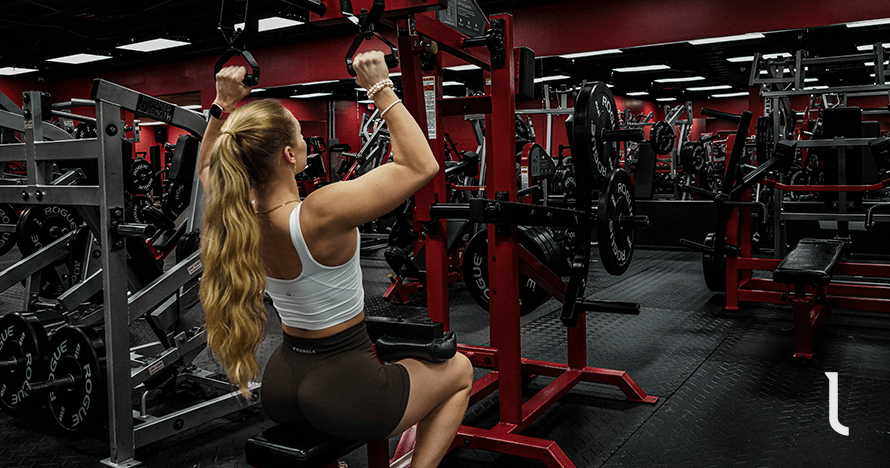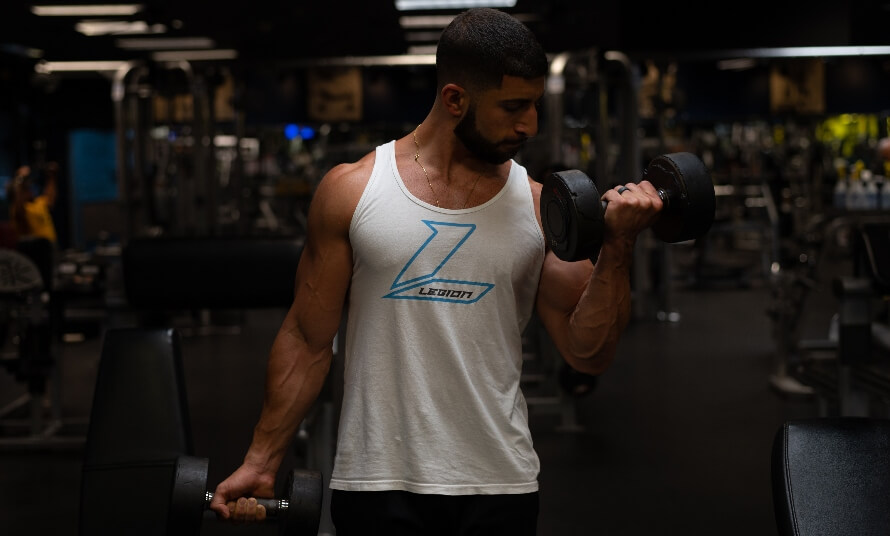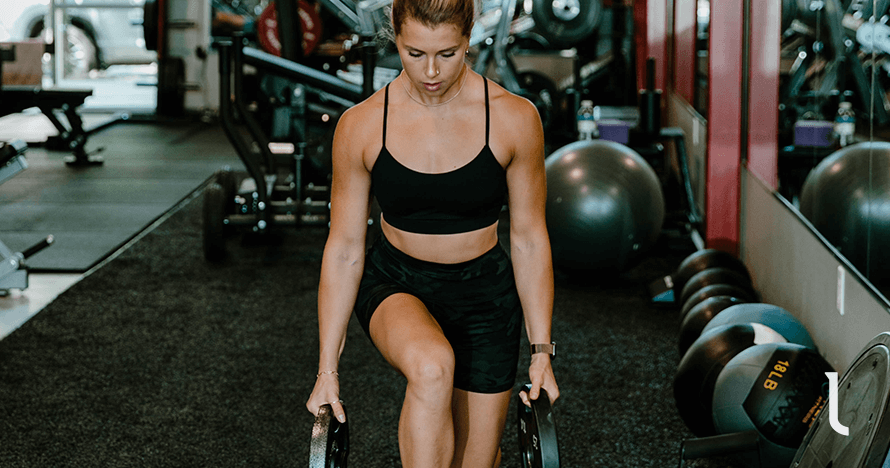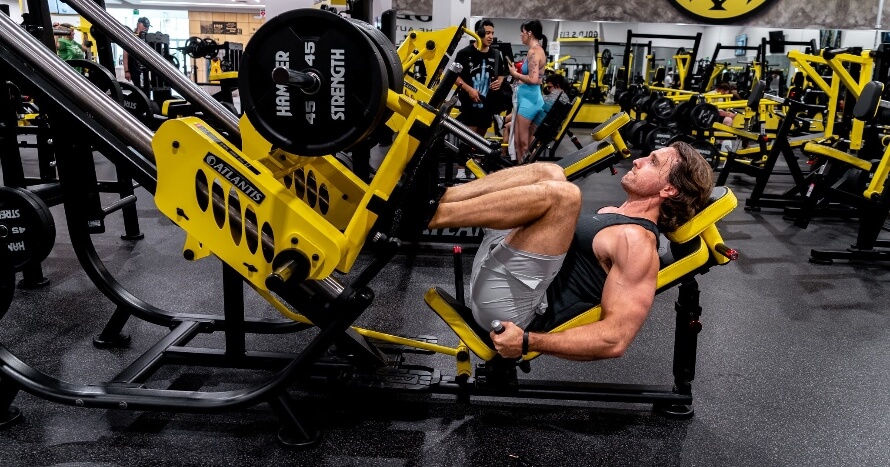The upper lower split is one of the most straightforward, flexible, and effective ways to organize your training.
It divides your workouts into upper-body and lower-body sessions, which lets you train all your major muscle groups multiple times weekly without burning out. That means you can lift heavy, recover fully, and make consistent progress without the fatigue or injury risk that can come with more complicated routines.
It’s also highly adaptable. Whether you want to train 2, 3, 4, or 5 days per week, there’s a version of the upper lower split that fits your schedule.
In this guide, you’ll learn the best upper lower split workouts for gaining size and strength, and how to organize them to build full-body muscle, no matter how many days you can train.
Key Takeaways
- The upper lower split is a training routine that divides your workouts into upper-body and lower-body sessions.
- It’s highly effective for building muscle and strength because it lets you train your entire body multiple times per week without wearing yourself out.
- You can tailor an upper lower split to your schedule by training 2, 3, 4, or 5 days per week. Each version has its pros and cons, but all can be effective when programmed correctly.
- To make as much progress as possible, train close to failure and focus on getting stronger over time.
- To get the most out of your upper lower split workouts, consider using a high-quality protein powder to help you reach your daily protein target, creatine to support recovery and muscle growth, and a pre-workout to enhance energy, focus, and performance.
Table of Contents
+
What Is the Upper Lower Split?

The upper lower split (often written “upper/lower split” and short for “upper body lower body split”) is a training routine that divides your workouts into upper- and lower-body workouts.
In upper-body workouts, you train all the major muscle groups in your upper body, including your chest, shoulders, back, and arms.
In lower-body workouts, you train all the major muscle groups in your lower body, including your quads, hamstrings, glutes, and calves.
A 4-day upper lower split is the most common version of the upper lower split workout routine. In this variation, you do two upper- and two lower-body workouts each week. For example, you might do upper-body workouts on Mondays and Thursdays, and lower-body workouts on Tuesdays and Fridays.
That said, the upper lower split routine is flexible, so you can easily rearrange workouts into a 2-, 3-, or 5-day upper lower split if this better suits your schedule and goals.
Upper Lower Split Routine Benefits

Here are five reasons the upper lower body split is one of the most effective ways to train for balanced, sustainable muscle and strength gains.
Balanced Muscle Growth
You give every major muscle group equal attention with the upper lower split. By dividing your workouts into upper- and lower-body sessions, you avoid overworking one area and neglecting another.
This balance helps you build proportional strength and an aesthetic physique.
Optimal Frequency
You usually train each muscle group twice a week on the upper lower training split, which research shows is more effective for gaining mass and strength than training them less often.
You also train different muscle groups on different days, giving each at least two days to recover while you work on others. This minimizes your risk of suffering repetitive strain injuries and ensures you can give maximal effort in your workouts, which helps with progressive tension overload—the primary driver of muscle growth.
READ MORE: What Is Progressive Overload Training?
High-Quality Training
When you train just one muscle group per workout, its performance typically plummets before your workout finishes. To compensate, you usually have to lift lighter weights or do fewer reps in your later sets, which stymies your progress over time.
With the upper lower split, you never train any one muscle group to the point of exhaustion. This allows you to perform high-quality reps with heavy weights throughout all your workouts, which is generally better for building muscle and gaining strength.
Reduced Soreness and Fatigue
You never train any single muscle to the point of exhaustion or on consecutive days with the upper lower split. This helps reduce soreness and cumulative fatigue, so you feel fresher throughout the week and can train harder, more consistently.
Simple Structure
The upper lower routine keeps things simple by focusing your workouts on large areas of your body. A straightforward routine like this makes training more enjoyable, and when you enjoy your workouts, you’re far more likely to stick with them (and see results!).
The upper lower split’s simplicity also makes it highly flexible. You can easily adjust it to fit your schedule, experience level, and goals without overhauling your entire routine.
The Best Upper Lower Split Workouts

The first step to building an effective upper lower split is mapping out each workout. Here are six you can use.
Upper-Body Workout #1:
- Barbell Bench Press: 3 sets | 4-to-6 reps | 3-to-5 min rest
- One-Arm Dumbbell Row: 3 sets | 4-to-6 reps | 3-to-5 min rest
- Incline Dumbbell Bench Press: 3 sets | 6-to-8 reps | 2-to-3 min rest
- Dumbbell Curl: 3 sets | 6-to-8 reps | 2-to-3 min rest
Upper-Body Workout #2:
- Overhead Press: 3 sets | 4-to-6 reps | 3-to-5 min rest
- Lat Pulldown: 3 sets | 4-to-6 reps | 3-to-5 min rest
- Dumbbell Side Lateral Raise: 3 sets | 6-to-8 reps | 2-to-3 min rest
- Dumbbell Rear Lateral Raise: 3 sets | 6-to-8 reps | 2-to-3 min rest
Upper-Body Workout #3:
- Close-Grip Bench Press: 3 sets | 4-to-6 reps | 3-to-5 min rest
- Chin-up: 3 sets | 4-to-6 reps | 3-to-5 min rest
- Triceps Pushdown: 3 sets | 6-to-8 reps | 2-to-3 min rest
- Barbell Curl: 3 sets | 6-to-8 reps | 2-to-3 min rest
Lower-Body Workout #1:
- Barbell Deadlift: 3 sets | 4-to-6 reps | 3-to-5 min rest
- Leg Press: 3 sets | 4-to-6 reps | 3-to-5 min rest
- Bulgarian Split Squat: 3 sets | 6-to-8 reps | 2-to-3 min rest
- Seated Calf Raise: 3 sets | 6-to-8 reps | 2-to-3 min rest
Lower-Body Workout #2:
- Back Squat: 3 sets | 4-to-6 reps | 3-to-5 min rest
- Romanian Deadlift: 3 sets | 4-to-6 reps | 3-to-5 min rest
- Lunge: 3 sets | 6-to-8 reps | 2-to-3 min rest
- Leg Curl: 3 sets | 6-to-8 reps | 2-to-3 min rest
Lower-Body Workout #3:
- Front Squat: 3 sets | 4-to-6 reps | 3-to-5 min rest
- Hip Thrust: 3 sets | 4-to-6 reps | 3-to-5 min rest
- Dumbbell Step-up: 3 sets | 6-to-8 reps | 2-to-3 min rest
- Sissy Squat: 3 sets | 6-to-8 reps | 2-to-3 min rest
The Best Upper Lower Split Schedules: 2-, 3-, 4- & 5-Day Routines

Now that you know what goes into making an effective upper lower split workout, let’s organize them into 2-,3-,4-, and 5-day plans and discuss the pros and cons of each approach.
2-Day Upper Lower Split
Schedule:
- Monday: Upper-Body Workout #1
- Tuesday: Rest
- Wednesday: Rest
- Thursday: Lower-Body Workout #1
- Friday: Rest
- Saturday: Rest
- Sunday: Rest
Pros:
The 2-day upper lower split is perfect if you have limited time to train but still want to build full-body muscle and strength. It’s also a great fit for athletes who need to prioritize training for their sport but want to also get the benefits of strength training with minimal time in the gym.
Cons:
If your goal is to gain muscle as quickly and effectively as possible, lifting more than two days per week is better. With just two sessions, it’s also hard to fit in enough volume (sets) to maximize progress.
3-Day Upper Lower Split
If you train three days per week, you have two options: a routine that emphasizes your upper body or one that emphasizes your lower body.
Schedule (Upper-Body Emphasis):
- Monday: Upper-Body Workout #1*
- Tuesday: Rest
- Wednesday: Lower-Body Workout #1
- Thursday: Rest
- Friday: Upper-Body Workout #2
- Saturday: Rest
- Sunday: Rest
* Substitute the One-Arm Dumbbell Row with the Barbell Deadlift. While many people think of the deadlift as a lower-body exercise, it actually trains your entire posterior chain (the muscles on the back of your body) so it works well in both upper- and lower-body workouts. It also lets you lift heavy weights and overload multiple major muscle groups at once, so it’s worth including in your routine.
Schedule (Lower-Body Emphasis):
- Monday: Lower-Body Workout #1
- Tuesday: Rest
- Wednesday: Upper-Body Workout #1
- Thursday: Rest
- Friday: Lower-Body Workout #2
- Saturday: Rest
- Sunday: Rest
Pros:
The 3-day upper lower split is ideal if you’re a beginner, need more recovery between sessions, or have a busy schedule. It lets you train several—though not all—major muscle groups twice per week, which benefits muscle and strength gains.
The generous rest between workouts helps you stay fresh, and the structure is highly flexible—you can bias the routine toward your upper or lower body depending on your goals, or alternate emphasis every 8-to-10 weeks for more balanced progress.
Cons:
Compared to higher-frequency routines, it’s harder to fit in enough weekly volume to maximize gains, which may slow your progress once you’re past the beginner stage of weightlifting.
And while you can shift the emphasis between your upper and lower body, you may risk developing imbalances if you stick with one focus for too long.
4-Day Upper Lower Split
Schedule:
- Monday: Upper-Body Workout #1
- Tuesday: Lower-Body Workout #1
- Wednesday: Rest
- Thursday: Upper-Body Workout #2
- Friday: Lower-Body Workout #2
- Saturday: Rest
- Sunday: Rest
Pros:
The upper lower 4-day split is the most balanced and versatile version of the split, making it a great option for nearly everyone. It allows you to train each major muscle group twice per week with enough weekly volume to maximize muscle and strength gains.
Despite the higher training frequency, the routine still includes three rest days per week, which is more than enough for most people to recover and perform well in every session.
Cons:
The main drawback is time commitment. Four weekly workouts are manageable for most, but it can be a challenge if your schedule fluctuates or you struggle to recover quickly between sessions.
5-Day Upper Lower Split
If you train five days per week, you can choose between two routines: one that emphasizes your upper body or one that emphasizes your lower body.
Schedule (Upper-Body Emphasis):
- Monday: Upper-Body Workout #1
- Tuesday: Lower-Body Workout #1
- Wednesday: Rest
- Thursday: Upper-Body Workout #2
- Friday: Lower-Body Workout #2
- Saturday: Upper-Body Workout #3
- Sunday: Rest
Schedule (Lower-Body Emphasis):
- Monday: Lower-Body Workout #1
- Tuesday: Upper-Body Workout #1
- Wednesday: Rest
- Thursday: Lower-Body Workout #2
- Friday: Upper-Body Workout #2
- Saturday: Lower-Body Workout #3
- Sunday: Rest
Pros:
The 5-day upper lower split is best suited to intermediate and advanced weightlifters who want to push their training volume higher. It gives you more opportunities to train each muscle group throughout the week, which can help accelerate muscle and strength gains—especially during a bulk or when trying to break through a plateau.
You can also shift the emphasis toward your upper or lower body depending on your goals, or alternate focus every few training cycles to stay well-rounded.
Cons:
This routine can be tough to recover from if your sleep, nutrition, or stress levels aren’t dialed in. It also requires a significant time commitment—training five days weekly isn’t realistic for everyone.
3 Tips for More Productive Upper Lower Split Workouts

1. End every set 1-to-3 reps shy of muscle failure.
As I explain in my fitness books for men and women, to maximize your results, you must take most of the sets in your upper lower split workouts to within a rep or two of failure.
Ask yourself at the end of each set, “If I had to, how many more reps could I have gotten with good form?” If the answer is more than two, increase the weight or reps to make your next set more challenging.
READ MORE: Does Training to Failure Help You Build More Muscle? What Science Says
2. Once you hit the top of your rep range for a set, move up in weight.
If your upper lower split workout calls for 4-to-6 reps of the bench press and you get 6 reps for a set, add 10 pounds to your next set.
If you manage 3 or fewer reps with the new weight, reduce the weight by 5 pounds to ensure you stay in the 4-to-6 rep range.
Follow this pattern of trying to add reps or weight to every exercise in every workout.
READ MORE: Double Progression Guide: How to Use Double Progression to Gain Muscle and Strength
3. Take the right supplements
These supplements can help you optimize your performance and gains while following an upper lower split routine:
- Protein powder: Protein powder, such as whey or casein, provides your body with the nutrients needed to build muscle tissue and recover from workouts. For a clean and delicious protein powder, try Whey+ or Casein+.
- Creatine: Creatine boosts muscle and strength gain, improves anaerobic endurance, and reduces muscle damage and soreness from your workouts. For a natural source of creatine monohydrate, try our creatine monohydrate, creatine gummies, or Recharge.
- Pre-workout: A high-quality pre-workout enhances energy, mood, and focus, increases strength and endurance, and reduces fatigue. For a top-tier pre-workout containing clinically effective doses of 6 science-backed ingredients, try Pulse with caffeine or without.
(If you’d like even more specific advice about which supplements you should take to reach your health and fitness goals, take the Legion Supplement Finder Quiz, and in less than a minute, you’ll know exactly what supplements are right for you.)
FAQ #1: Is the upper lower split good?
Yes—the upper lower split is one of the most effective ways to build muscle and strength. Most variations of the routine let you train each major muscle group at least twice per week, which research shows is ideal for maximizing progress.
It’s also flexible enough to work with almost any schedule and simple enough for beginners while still offering enough training volume for advanced weightlifters.
FAQ #2: What’s the best upper lower split?
It’s hard to say which upper lower split is best since it depends on your schedule, goals, and circumstances.
That said, the 4-day upper lower split routine is the most popular version of the upper lower split because it lets you train your entire body with plenty of volume while still giving you three rest days each week. This balance makes it great for building muscle and strength without wearing you out.
FAQ #3: What is the “PPL upper lower split?”
The PPL upper lower split is a 5-day routine that combines the push pull legs and upper lower splits. The schedule usually looks something like this:
- Monday: Push
- Tuesday: Pull
- Wednesday: Legs
- Thursday: Rest
- Friday: Upper
- Saturday: Lower
- Sunday: Rest
READ MORE: An Expert Guide to the Push Pull Legs Upper Lower (PPLUL) Split
FAQ #4: Is the upper lower split better than PPL?
Both the PPL (push pull legs) and upper lower splits are excellent training routines for gaining muscle and strength. Neither is inherently better than the other; which you choose depends on your schedule and preferences.
For example, you’ll probably prefer PPL if you can only train three days a week or like to focus on one muscle group or “movement pattern” per session. Conversely, if you can train four days a week and prefer spreading out your volume to avoid muscle soreness, the upper lower split is likely better.
READ MORE: The Ultimate Guide to the Push Pull Legs Workout Routine
FAQ #5: What’s the “upper lower + arms” split?
The “upper lower + arms” split is a variation of the traditional upper lower split that adds a dedicated arm day to the weekly schedule. Instead of training arms alongside your upper-body muscles twice per week, you dedicate a full workout to biceps and triceps.
Here’s how it might look:
- Monday: Upper-Body Workout #1
- Tuesday: Lower-Body Workout #1
- Wednesday: Rest
- Thursday: Upper-Body Workout #2
- Friday: Lower-Body Workout #2
- Saturday: Arms
- Sunday: Rest
This approach can work well if your arms are lagging or if you simply enjoy training them more frequently. That said, it’s unnecessary for most people—adding arm work to your upper-body days is usually enough and doesn’t significantly increase the length of your workouts.
READ MORE: The Best Arm Workouts for Building Mass
Scientific References +
- “Comparison of 1 Day and 3 Days per Week of Equal-Volume... : The Journal of Strength & Conditioning Research.” LWW, 2019, journals.lww.com/nsca-jscr/Abstract/2000/08000/Comparison_of_1_Day_and_3_Days_Per_Week_of.6.aspx.
- Crewther, Blair, et al. “The Effects of Two Equal-Volume Training Protocols upon Strength, Body Composition and Salivary Hormones in Male Rugby Union Players.” Biology of Sport, vol. 33, no. 2, 6 Mar. 2016, pp. 111–116, www.ncbi.nlm.nih.gov/pmc/articles/PMC4885621/, https://doi.org/10.5604/20831862.1196511.
- Paz, G.A. , et al. Muscle Activation and Volume Load Performance of Paired Resistance Training Bouts with Differing Inter-Session Recovery Periods. Apr. 2021, https://doi.org/10.1016/j.scispo.2020.02.011.
- Ochi, Eisuke , et al. Higher Training Frequency Is Important for Gaining Muscular Strength under Volume-Matched Training. 1 July 2018, https://doi.org/10.3389/fphys.2018.00744.
- Stokes, Tanner, et al. “Recent Perspectives Regarding the Role of Dietary Protein for the Promotion of Muscle Hypertrophy with Resistance Exercise Training.” Nutrients, vol. 10, no. 2, 7 Feb. 2018, p. 180, www.mdpi.com/2072-6643/10/2/180/pdf, https://doi.org/10.3390/nu10020180.
- Eckerson, Joan M., et al. “Effect of Creatine Phosphate Supplementation on Anaerobic Working Capacity and Body Weight after Two and Six Days of Loading in Men and Women.” The Journal of Strength and Conditioning Research, vol. 19, no. 4, 2005, p. 756, https://doi.org/10.1519/r-16924.1.
- Bassit, Reinaldo Abunasser, et al. “Effect of Short-Term Creatine Supplementation on Markers of Skeletal Muscle Damage after Strenuous Contractile Activity.” European Journal of Applied Physiology, vol. 108, no. 5, 3 Dec. 2009, pp. 945–955, https://doi.org/10.1007/s00421-009-1305-1.










